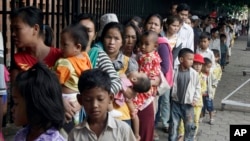Cambodia has one of the highest maternal mortality rates in the region, and despite UN goals set up for the end of 2015, that number has remained high.
More than 1,000 mothers die each year during pregnancy or childbirth—a figure that is down nearly half from 2000, but one that falls short of the UN Millennium Development Goals set by the government.
The rate of maternal mortality is 170 per 100,000 live births, short of the 140 per 100,000 rate the government set for itself originally. The government has since adjusted that goal, and health officials say the rate is decreasing, which is a positive sign.
“We’ve put the target at 250 per 100,000 live births, because this is what the Millennium Development Goals require, which is to reduce to two-thirds the level of 1990,” Tung Raththavy, director of the Ministry of Health’s National Maternal and Child Health Center, said.
“So if we look at the rate in 1990, where there were 900 deaths in 100,000 live births, then in 2015 we have to reduce it to 250 per 100,000 live births,” she said. “Now we have reached 170. I think this is our pride. We have been acknowledged for what we’ve accomplished.”
Many mothers die during childbirth due to a lack of medical care, particularly in emergencies, due to a lack of trained medical personnel across the country, according to Unicef. “Even when mothers can access healthcare, overall quality of care is deficient, magnifying the challenges women face in overcoming potential health problems during and after birth,” the agency said in a recent report.
Ke Sovannaroth, head of the National Assembly’s committee on health and women’s affairs, said the government needs to focus more on maternal health. Thailand’s maternal mortality rate is 48 in 100,000 live births. Vietnam’s rate is 59 in 100,000. Cambodia rate, she said, is only better than Laos, which sees 470 deaths per 100,000 live births.
Related targets include increasing the number of births handled by skilled medical workers, from 32 percent in 2000 to 87 percent in 2015.
Tung Raththavy said that number has surpassed the goal, reaching 89 percent in 2014. Cambodia has doubled its number of health clinics, to 1,000, over the last decade, she said.
“In the future, we are planning to expand more, to bring services closer to the people, especially women and children,” she said. “So we still need staff. We still need more skilled midwives to do this work in these places, where we are still lacking. We won’t stop. We have been working a lot to increase resources, especially skilled birth attendants.”
Ke Sovannaroth said the reports she has received indicate pregnant women still have to pay, despite government claims that the service is free for the poor.
“We have found that women died from childbirth due to the neglect of their doctors, but we do not see the government punish those who have done wrong,” she added.
Another area for improvement is the reduction in patients with iron deficiency and anemia, which many women face during pregnancy.
“We found that rates of anemia have decreased a lot, but not to the goal we want,” Tung Raththavy said. “However, we found that the level of severe anemia, which originally was high, has been reduced to lower than one percent, so we have been working hard on this.”
Although health officials have shown much better figures at the national level, the people who live in remote provinces, such as Koh Kong, Ratanakkiri and Mondolkiri, still have higher maternal mortality rates than the national average.
There, only 75 percent of women giving birth were attended by trained health workers in 2012, according to the Cambodian Millennium Development Goals Report 2014.







